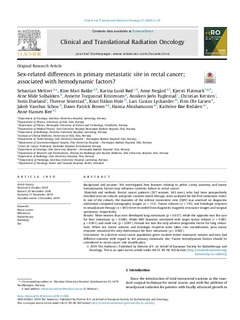| dc.contributor.author | Meltzer, Sebastian | |
| dc.contributor.author | Bakke, Kine Mari | |
| dc.contributor.author | Rød, Karina Lund | |
| dc.contributor.author | Negård, Anne | |
| dc.contributor.author | Flatmark, Kjersti | |
| dc.contributor.author | Solbakken, Arne Mide | |
| dc.contributor.author | Kristensen, Annette Torgunrud | |
| dc.contributor.author | Fuglestad, Anniken Jørlo | |
| dc.contributor.author | Kersten, Christian | |
| dc.contributor.author | Dueland, Svein | |
| dc.contributor.author | Seierstad, Therese | |
| dc.contributor.author | Hole, Knut Håkon | |
| dc.contributor.author | Lyckander, Lars Gustav | |
| dc.contributor.author | Larsen, Finn Ole | |
| dc.contributor.author | Schou, Jakob Vasehus | |
| dc.contributor.author | Brown, Dawn | |
| dc.contributor.author | Abrahamsson, Hanna Josefine | |
| dc.contributor.author | Redalen, Kathrine | |
| dc.contributor.author | Ree, Anne Hansen | |
| dc.date.accessioned | 2020-02-05T12:28:53Z | |
| dc.date.available | 2020-02-05T12:28:53Z | |
| dc.date.created | 2019-12-03T20:59:34Z | |
| dc.date.issued | 2019 | |
| dc.identifier.citation | Clinical and Translational Radiation Oncology. 2019, 21 5-10. | nb_NO |
| dc.identifier.issn | 2405-6308 | |
| dc.identifier.uri | http://hdl.handle.net/11250/2639823 | |
| dc.description.abstract | Background and purpose
We investigated how features relating to pelvic cavity anatomy and tumor hemodynamic factors may influence systemic failure in rectal cancer.
Materials and methods
Rectal cancer patients (207 women, 343 men), who had been prospectively enrolled onto six cohorts and given curative-intent therapy, were analyzed for the first metastatic event. In one of the cohorts, the diameter of the inferior mesenteric vein (IMV) was assessed on diagnostic abdominal computed tomography images (n = 113). Tumor volume (n = 193) and histologic response to neoadjuvant therapy (n = 445) were recorded from diagnostic magnetic resonance images and surgical specimens, respectively.
Results
More women than men developed lung metastasis (p = 0.037), while the opposite was the case for liver metastasis (p = 0.040). Wider IMV diameter correlated with larger tumor volume (r = 0.481, p < 0.001) and male sex (p < 0.001). Female sex was the only adverse prognostic factor for lung metastasis. When sex, tumor volume, and histologic response were taken into consideration, poor tumor response remained the only determinant for liver metastasis (p = 0.002).
Conclusions
In a diverse rectal cancer population given curative-intent treatment, women and men had different outcome with regard to the primary metastatic site. Tumor hemodynamic factors should be considered in rectal cancer risk stratification. | nb_NO |
| dc.language.iso | eng | nb_NO |
| dc.publisher | Elsevier | nb_NO |
| dc.rights | Attribution-NonCommercial-NoDerivatives 4.0 Internasjonal | * |
| dc.rights.uri | http://creativecommons.org/licenses/by-nc-nd/4.0/deed.no | * |
| dc.title | Sex-related differences in primary metastatic site in rectal cancer; associated with hemodynamic factors? | nb_NO |
| dc.type | Journal article | nb_NO |
| dc.type | Peer reviewed | nb_NO |
| dc.description.version | publishedVersion | nb_NO |
| dc.source.pagenumber | 5-10 | nb_NO |
| dc.source.volume | 21 | nb_NO |
| dc.source.journal | Clinical and Translational Radiation Oncology | nb_NO |
| dc.identifier.doi | 10.1016/j.ctro.2019.11.006 | |
| dc.identifier.cristin | 1756283 | |
| dc.description.localcode | (C) 2019 The Author(s). Published by Elsevier B.V. on behalf of European Society for Radiotherapy and Oncology. This is an open access article under the CC BY-NC-ND license (http://creativecommons.org/ licenses/by-nc-nd/4.0/). | nb_NO |
| cristin.unitcode | 194,0,0,0 | |
| cristin.unitname | Norges teknisk-naturvitenskapelige universitet | |
| cristin.ispublished | true | |
| cristin.fulltext | original | |
| cristin.fulltext | postprint | |
| cristin.qualitycode | 1 | |

